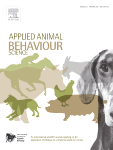Document type: Scientific article published in Animals
Authors: Francesca Carnovale, Jin Xiao, Binlin Shi, Tanel Kaart, David Arney, Clive J. C. Phillips
Preview: Low temperatures can provide a risk to the welfare of sheep during transport because of increased ventilation chilling the sheep, and we examined the importance of three factors-covering the vehicle, duration of transport, and feeding prior to transport-on the welfare of sixty transported 4-month-old Dorper × Mongolian female sheep in a cold climate. Sheep in a covered vehicle had greater increases in head and ear temperatures than those in an open vehicle. Sheep transported for 2 h increased their leg temperatures, whereas those transported for 1 h had reduced leg temperatures. Increases in non-esterified fatty acids (NEFA) and lactate dehydrogenase (LDH) in the blood samples during the long transport suggested that sheep had more muscular and metabolic activity, compromising their well-being. Feeding prior to transport did not affect body temperatures, but those not fed prior to transport had reduced alanine transferase, HSP and cortisol in their blood, whereas those that were fed had reduced NEFAs, LDH and creatine kinase. Prior feeding had no effect on the sheep temperature indices over a two-hour transport period. Thus, the sheep most at risk of the adverse effects of cold temperatures were those transported in open vehicles, those transported for a longer time, and those not fed before transport.






